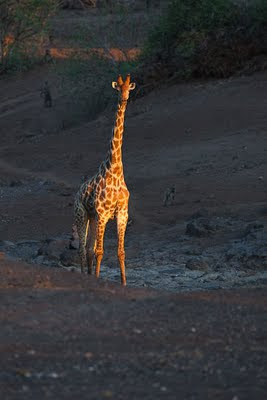Part 2 of our Mashatu photo workshop trip report. The workshop was lead by Isak Pretorius. All text and images by Isak.
Game drive 5, Monday afternoon: The weather cleared and we were in for a sunny few days ahead. Not far from camp our first sighting was a leopard stalking impala. As if the leopard read a book on photography it provided us with perfect photographic moments, walking slowing towards us over big flat rocks with the sun perfectly over our shoulders, and golden light illuminating the eyes of the leopard. We could not ask for more. Unfortunately the impala caught sent of the leopard which spoiled the stalking attempt, so we moved on to landscape opportunities of big ana trees in a dry riverbed, and a colony of whitefronted bee-eaters. Our drive finished with star photography when we identified a beautiful shepherd's tree on an open plain. We had so much fun trying different angles and getting the exposure correct that Daniel had to radio in to camp that we were going to be and hour and a half late for dinner.
Game drive 6, Tuesday morning: After all the excitement of the previous evening we were all keen on taking it slow this morning. The euphorbia’s on top of the white cliffs in the Mujali river provided good opportunity to do early morning landscapes. Not far from that we stopped at a big pool in the riverbed where we spent the rest of the morning watching impala, baboon, and kudu coming to drink. The birdlife was also impressive with a black stork and pied kingfisher fishing in the pool and green pigeons coming down for a drink.
Game drive 7, Tuesday afternoon: I asked the group if there were any of the photographic opportunities we had which they’d like to do again and the unanimous answer was to go back to the bee-eaters. We headed straight for the bee-eaters colony and on the way there we stopped for more landscapes of big trees in dry riverbeds. This became a popular theme on our trip because everyone loved the creative opportunities that it provided. As promised we ended up at the bee-eater colony again, after which we had sundowner drinks before heading back to camp. On our way back we identified a tree for a star trail and could managed a twenty-minute exposure before the moon started to rise over the horizon.
Game drive 8, Wednesday morning: Trying to make the most of our last game drive we were desperate to find anything interesting to photograph. It was not long before we found a large herd of impala running, redbilled queleas, and two few-day-old crowned lapwing chicks and their parents. Soon after that we heard on the radio about some baboons harassing a leopard and we headed straight for it. On top of a hill we found our favourite leopard, the young male, lying in the shade of a bush being followed by about eight young male baboons. The baboons were all around him and very cautious in their attempts of mock-charging the leopard, probably just to drive him away far enough away from the rest of their troop. The young male baboons were quickly joined by more baboons, including a few big males with big teeth. The mock changes continued and although in the beginning the leopard did not look to care too much for them, he now started feeling more and more vulnerable and made a few charges at the baboons himself. The tension mounted and it was like a pressure cooker getting ready to explode. After another charge by one of the big male baboons the leopard made a run for it, and as soon as the leopard turned his back to the baboons and started running away, all hell broke loose. The whole lot of baboons ran after the leopard and was on his tale in a matter of seconds. Some of the baboons pulled the leopard’s tail and in a cloud of dust the leopard retreated to lying on his back, claws in the air and ready to defend himself. The baboons were all around him, jumping over him and attacking. This all happened in a matter of seconds. Then, the leopard saw a gap, got up and ran as fast as he could away from the baboons. The baboons stopped, turned around and went back to their troop, happy that the leopard was far enough away from their young ones. As a natural history moment this was something spectacular which none of us will ever forget.
After all this excitement we stopped for coffee at a baobab tree in a dry riverbed where we had a last chance to do some landscape photography. We headed back to camp for brunch before heading home.
Meeting as strangers and leaving as friends, the trip was a huge success where everyone learned a lot and got great shots. Mashatu delivered again and it’s a pleasure to work in an area that provides such good and unique opportunities.
This article first appeared on C4 Images and Safaris Blog
Thursday, October 15, 2009
Subscribe to:
Post Comments (Atom)







No comments:
Post a Comment